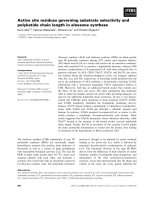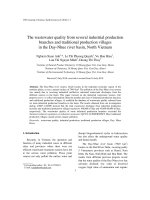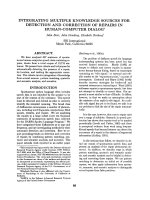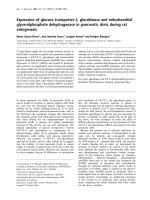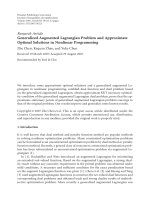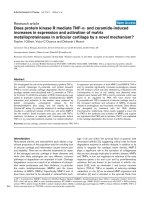Báo cáo " The wastewater quality from several industrial production branches and traditional production villages in the Day-Nhue river basin, North Vietnam " ppt
Bạn đang xem bản rút gọn của tài liệu. Xem và tải ngay bản đầy đủ của tài liệu tại đây (83.74 KB, 7 trang )
VNU Journal of Science, Earth Sciences 26 (2010) 1-7
1
The wastewater quality from several industrial production
branches and traditional production villages
in the Day-Nhue river basin, North Vietnam
Nghiem Xuan Anh
1,
*, Le Thi Phuong Quynh
1
, Vu Huu Hieu
1
,
Luu Thi Nguyet Minh
2
, Duong Thi Thuy
3
1
Institute of Natural Product Chemistry, 18 Hoang Quoc Viet, Cau Giay, Hanoi
2
Institute of Chemistry, 18 Hoang Quoc Viet, Cau Giay, Hanoi
3
Institute of Environmental Technology, 18 Hoang Quoc Viet, Cau Giay, Hanoi
Received 5 July 2010; received in revised form 16 July 2010
Abstract. The Day-Nhue river system, which locates in the important economic region of the
northern plains, covers a natural surface of 7949 km². The pollution of the Day-Nhue river system
was mainly due to receiving untreated/ ineffective untreated wastewater discharges from the
different sources in the basin. This paper focused on the industrial wastewater sources. Our
purposes are to i) collect information about the number and sizes of industrial production factories
and traditional production villages; ii) establish the database of wastewater quality released from
six main industrial production branches in the basin. The results obtained from our investigation
during 1/2007–12/2009 showed that the total wastewater discharge from industrial production
factories and traditional production villages reached to 100,000 m
3
/day and 45,000-60,000 m
3
/day,
respectively. The wastewater quality of some industrial production branches exceeded the
National technical regulation on industrial wastewater QCVN 24:2009/BTNMT. Most traditional
production villages caused serious organic pollution.
Keywords: wastewater quality, industrial production, traditional production villages, Day- Nhue
River.
1. Introduction
∗
Recently, in Vietnam, the operation and
function of many industrial zones in different
cities and provinces where there were not
efficient wastewater treatment systems have led
to the serious water pollution. These point
sources not only pollute the surface water and
_______
∗
Corresponding author. Tel.: 84-4-37916621.
E-mail:
disrupt biogeochemical cycles in hydrosystem
but also affect the underground water quality
and human health.
The Day-Nhue river basin (7949 km
2
)
locates in the Red River Delta, covering partly
5 Vietnamese provinces such as Hanoi, Nam
Dinh, Ha Nam, Ninh Binh and Hoa Binh. The
results from different previous projects reveal
that the water quality of the Day-Nhue river has
seriously declined: low value of dissolved
oxygen, high value of ammonium and organic
N.X. Anh et al. / VNU Journal of Science, Earth Sciences 26 (2010) 1-7
2
matters [1]. The causes of river water pollution
are direct wastewater discharges without
treatment or ineffective treatment [1,2].
Presently, the Day-Nhue river is utilized to
provide water for agricultural and industrial
activities, and notably used as domestic water
for the many inhabitants in its basin. Therefore,
the urgent needs are to reduce and eliminate the
water pollution. To fulfill these requirements, in
the first step, we have to investigate the
pollution sources both quantitatively and
qualitatively in order to give the best solutions
for ameliorating the water quality in this basin.
In this study, we i) collected information
about the number and sizes of industrial
production factories and traditional production
villages; ii) established the database of
wastewater quality released from six main
industrial production branches in the Day-Nhue
river basin. The results could contribute to the
database construction, attending to the
environment protection, management and
sustainable development in Vietnam in general
and especially in the Dayr-Nhue river basin.
2. Methods
A database of industrial factories and
traditional production villages was built using
MS Excel software. All information concerning
the factories such as production, wastewater
discharge, wastewater quality, water volume
utilization, wastewater treatment system, etc
was drawn from different documentation
sources (Reports on environmental statement
from DOSTs of different provinces in the basin;
reports from previous projects on the Day river
basin ). About 600 factories, (among
approximately 4113 factories in the whole Day
river basin [2]) in the five provinces mentioned
above, were selected to establish the necessary
database. 600 questionnaires were sent directly
to the factories, which locate in the Day-Nhue
river basin, for information.
Parallel with the documentation process, the
wastewater samplings were conducted from
April to December 2007 in Hanoi, Ha Nam,
Hoa Binh and Ninh Binh provinces. The
physicochemical variables were directly
measured in-situ by the Water Quality Checker
equipment WQC-22A (TOA, Japan). The
wastewater sampling procedure observes to the
Vietnamese Standards TCVN 5999-1995. The
analytical methods were based on the American
Standards [3].
3. Results and discussion
3.1. Development of industrial production in
the Day-Nhue river basin
3.1.1. Development of industrial factories:
Along with the agricultural development,
the manufacturing industry in the Day-Nhue
basin in recent years has rapidly increased; both
in scales and diversity.
The percentage of different industrial
branches in the Day-Nhue river basin were
shown in the table 1 [4].
Table 1. Percentage (%) of some main industrial
branches in the basin
STT Industrial branches Ratio (%)
1 Mechanics 32.1
2 Food processing 15.1
3 Textile 13.3
4 Chemicals 8.3
5 Construction materials 12.8
6 Others 18.3
According to the 2006 national report of the
Environmental state [2], in the Day-Nhue river
basin, there were about 4113 factories (data
recorded in 2004), distributed unevenly in 5
provinces. About 79% of the factories locate in
Hanoi, 10% in Nam Dinh, 5% in Ninh Binh,
N.X. Anh et al. / VNU Journal of Science, Earth Sciences 26 (2010) 1-7
3
4% in Ha Nam and 2% in Hoa Binh province
[5]. Important industrial zones in this basin are
Thuong Dinh, Vinh Tuy, Cau Dien, Cau Buou,
Van Dien, Phu Xuyen, Thuong Tin, Ha Dong…
3.1.2. Development of traditional production
villages
In recent years, the traditional production
villages have been revived and enhanced. The
Ministry of Science and Technology [2] reports
that there were 458 traditional production
villages in the Day-Nhue river basin, and 936
traditional production villages in all five
provinces (Table 2).
The traditional production villages are
distributed unevenly in five provinces. About
67% of traditional production villages locate in
Hanoi, 19.7% in Nam Dinh, 8.7% in Ha Nam,
3.7% in Ninh Binh, and 0.9% in Hoa Binh
province.
Table 2. Distribution of traditional production villages by the industrial production branches
in five provinces
Province Number
of villages
Textile
- dyeing
Food
process.
Solid waste
recycle
Handicrafts
Construction materials
Other
Ha Noi 328 27 48 12 183 4 54
Ha Nam 17 2 2 1 9 - 3
Nam Dinh
90 12 21 10 20 - 27
Ninh Binh
17 1 11 7 - - -
Hoa Binh
15 14 1 - - - -
3.2. Wastewater discharge and its quality
3.2.1. Wastewater quality from industrial
production
According to reports from the Provincial
People Committees [5], Hanoi city discharges
the highest volume of industrial wastewater
(76.000 m
3
/d, about 76% of the total
wastewater releases in the Day-Nhue river
basin), and about 8% from the Ha Nam
province; 7% from the Nam Dinh, 7% from the
Ninh Binh province and 2% from the Hoa Binh
province.
The wastewater quality of six industrial
branches in this basin was summarized from
literature data, from the questionnaire results
and also from our real sampled and analytical
results.
Physicochemical variables: The results of
physicochemical variables which were
summarized from literature data and also from
our real analysis were shown in the table 3. The
results revealed that the mean pH values of
wastewater discharged from six industrial
branches were from neutral to alkaline (6.7 –
8.1). The pH values of wastewater from the
mechanics and textile are the highest (8.4 and
8.1 respectively) while the lowest from food
processing (6.7). The mean conductivity
reached the lowest value (365.5 µS/cm) in
wastewater from the construction materials and
the highest value (1028.2 µS/cm) from the
mechanics. The suspended solids (SS) is an
important factor which impacts development of
aquatic organisms [7]. The mean SS
concentrations from almost industrial branches
exceeded the National technical regulation on
industrial wastewater QCVN 24:2009/BTNMT
column B (Table 3). Note that the SS contents
in wastewater from the papers, chemicals,
construction materials and food processing
were 4.6, 2.8, 1.8, and 1.2 times higher,
respectively, than the QCVN 24:2009/BTNMT,
column B.
N.X. Anh et al. / VNU Journal of Science, Earth Sciences 26 (2010) 1-7
4
Table 3. Mean values of some physicochemical variables of wastewater from six industrial branches
Branches pH TDS (mg/l)
Conductivity (µS/cm)
SS (mg/l) DO (mg/l)
Mechanic 8.4 630.0 1028.2 125.7 3.50
Food processing 6.7 402.4 880.8 384.5 1.56
Chemicals 7.5 490.5 530.6 2511.8 2.91
Papers 7.4 223.0 462.8 1233.8 1.82
Textile-dyeing 8.1 852.6 827.0 551.9 2.01
Construction materials 7.6 125.6 365.5 177.9 3.90
Nitrogen and phosphorus contents: In
water environment, nitrogen and phosphorus
are two indispensable elements for the aquatic
organism development but when their
concentrations in water are so high, they could
cause eutrophication, and break the ecological
balance in hydrosystem [7]. The N and P
contents in industrial wastewater were quite
different. The results showed that the mean
nitrate concentration in wastewater from six
industrial branches varied from 0.31 – 2.71
mgN/l, with the highest value obtained from
textile and the lowest value obtained from
construction materials. The mean ammonium
values in wastewater from six industrial
branches varied from 1.02 to 6.39 mgN/L, with
the highest value obtained from mechanics and
the lowest value obtained from construction
materials. The Center of Environment and
Applied Geology [8] reported that wastewater
from the chemicals, bating and alcohol–beer
production often released a larger amount of
ammonium than the other industrial
productions. The total phosphorus contents in
wastewater from the mechanics, textile and
food processing were higher than ones from the
paper, chemicals and construction materials.
Note that the mean value of total phosphorus in
wastewater from the mechanics exceeded the
National technical regulation on industrial
wastewater QCVN 24:2009/BTNMT, column
A.
Organic matter concentrations
Information from literature data and from
the questionnaire results showed that the mean
COD values in wastewater from six industrial
branches exceeded the National technical
regulation on industrial wastewater QCVN
24:2009/BTNMT column B (100mg COD/l).
Especially, the mean COD values from the
paper and food processing branches were very
high (901.4 and 417.5 mg/l respectively). Most
of the mean BOD
5
values in wastewater from 6
industrial branches exceeded the National
technical regulation on industrial wastewater
QCVN 24:2009/BTNMT column A (30 mg/l).
The mean BOD
5
content in wastewater from the
paper production and food processing are the
highest (238.1 mg/l and 174.4 mg/l
respectively), about 4.8 and 3.5 times higher,
respectively than the QCVN 24:2009/BTNMT
column B (50mg/l). The lowest value was
recorded from the textile production (24.2 mg/l)
(Figure 1).
N.X. Anh et al. / VNU Journal of Science, Earth Sciences 26 (2010) 1-7
5
Figure 1. COD and BOD
5
values in wastewater
from six industrial branches.
3.2.2. Wastewater quality from traditional
production villages
In the one hand, the traditional production
villages increase the production of goods and to
create jobs for local inhabitants. In other hand,
they release chemical contaminants and
seriously cause surface water pollution because
of the lack of wastewater treatment facilities.
Presently, in the basin, the traditional
production villages discharge about 45,000 -
60,000 m
3
wastewater/day. Note that
wastewater from the traditional production
villages in Ha Tay province (now included in
Hanoi city) accounts for 40% [2].
The results from the previous investigations
[2,4,6] focusing on traditional production
village environment indicated that the
wastewater quality from the food processing
was the worst (table 4). Several variables such
as SS, COD, BOD, N, P concentrations in
wastewater from food processing far exceeded
the QCVN 24:2009/BTNMT, column B.
Regarding to the paper mills, wastewater from
the paper processing and recycling also impact
significantly surface water quality.
Table 4. Wastewater quality from traditional production villages in the Day-Nhue river basin
Production
pH
-
SS
(mg/l)
BOD
(mg/l)
COD
(mg/l)
NH
4
mgN/l N total mgN/L
P total
mgP/l
Foods 6.1 1634 1265 1841 44.0 156.1 17.0
Papers 7.0 204.5 297 544.7 30.3 34.3 0.5
Plastic recycling 6.9 340.4 109 189.2 14.2 17.0 0.2
Metal recycling 6.1 30.0 114 72.0 1.5 4.7 0.2
Textile 6.6 135.0 135 172.2 1.5 3.4 0.2
Chemicals 6.6 183.0 125 345.0 1.5 8.8 0.4
QCVN 24:2009/BTNMT,
column B
5.5- 9.0 100 50 100 10 30 6
4. Conclusions and Petition
4.1. Conclusions
In recent years, in the Day-Nhue river
basin, the industry has been developed quickly
and contributed significantly to the economic-
social development. However, the industrial
production activities have also impacted
notably the environment. Considering the six
main industrial production branches
(mechanics, food processing, chemicals, papers,
textile – dyeing and construction materials) in
0
100
200
300
400
Mechanics
Food
proc.
Chemicals
Papers
Textile
Cons.
Material.
BOD
5
, mg/l
QCVN col. A
QCVN col. B
0
200
400
600
800
1000
Mechanics
Food
proc.
Chemicals
Papers
Textile
Cons.
Material.
COD, mg/l
QCVN col. A
QCVN col. B
N.X. Anh et al. / VNU Journal of Science, Earth Sciences 26 (2010) 1-7
6
the basin, the factories/traditional production
villages distributes unevenly: most of them
locate in Hanoi agglomeration.
Many industrial production factories/
traditional production villages have no
wastewater treatment system or ineffective
treatment facilities and released directly
wastewater to surface water bodies, leading to
serious water pollution. The data which were
synthesized from the literature and also from
our sampled and analyzed results indicated that
the wastewater variables (SS, nutrients and
organic matters) of some industrial factories in
the Day-Nhue river basin exceeded the QCVN
24:2009/BTNMT. Note that the COD and BOD
values in wastewater far exceeded the National
technical regulation on industrial wastewater
QCVN 24:2009/BTNMT. Considering the
traditional production villages, wastewater has
been serious polluted, notably from food
processing and paper recycling. In addition,
total that wastewater discharges of industrial
production factories and of traditional
production villages reached about 100,000
m
3
/day and 45,000 - 60,000 m
3
/day
respectively. Therefore, effective and urgent
measures must be applied in order to ameliorate
the environmental state of the Day-Nhue river
basin.
4.2. Petition
Some measures are proposed:
- Regularly monitor wastewater quality of
the industrial factories. Thoroughly treat
wastewater of factories in all provinces of the
Day-Nhue River basin.
- Encourage industrial companies in the
basin to improve production technologies and
to ameliorate the wastewater treatment system
in order to observe the Vietnamese standards.
The new investment projects could be accepted
if they could have environment impact
assessment reports.
- Enhancing the activities of communication
and education in order to raise the awareness
about environmental protection of the factories
and local people.
Acknowledgments
This work was carried out at first in the
scope of the scientific cooperation between
CNRS teams (France) and VAST teams
(Vietnam) in the project “Study on water
quality of Day river basin”. And then, it was
developed in the AUF action 2092 RR823-923
project. We are grateful to financial support
from the Vietnamese Ministry of Science and
Technology and the Agence Universitaire de la
Francophonie (AUF).
References
[1] Nghiem X.A, Le T.P.Q, Vu H.H, Duong T.T,
Đang Đ.K. Organic pollution in the Day_nhue
river system: present situation and causes. J.
Science and Technology. Vol 48(4A): 376 –
382, 2010.
[2] MOST, Ministry of Science and Technology.
National Report in 2006: Environmental
statement of the 3 river basins: Cau, Nhue-Day
and Dong Nai river, 2007.
[3] APHA (American Public Health Association),
Standard Methods for the Examination of Water
and Wastewater, 1995.
[4] Nguyen Van Cu et al., Final report of the
national project “Construction of the general
project for environmental protection of the Day-
Nhue river basin. 2005.
[5] Provincial People Committees of Hanoi, Ha
Nam, Ha Tay, Nam Dinh, Ninh Binh, Hoa Bình.
Project for general environmental protection of
the Nhue-Day basin, 117 pages, 2007.
N.X. Anh et al. / VNU Journal of Science, Earth Sciences 26 (2010) 1-7
7
[6] Dang K.C, Nguyen N.L, Tran L.M., Traditional
production villages in Vietnam and
Environment, Science and technology Editor,
392 pages, 2005.
[7] Meybeck M. and Ragu A., River discharges to
the oceans: An assessment of suspended solids,
major ions and nutrients, UNEP Env.
Information and Assessment Report, Nairobi,
245pp, 1996.
[8] Center for Environment and Geography
Applied, Report “Investigation and assessment
for plan establishment for environmental
protection in fitting with the national
environmental development and protection
strategy in 2010 and oriented in 2020s (Hanam
is an example)”, 139 pages, 2004.
Chất lượng nước thải một số ngành sản xuất công nghiệp
và tiểu thủ công nghiệp trong lưu vực sông Đáy-Nhuệ,
Bắc Việt Nam
Nghiêm Xuân Anh
1
, Lê Thị Phương Quỳnh
1
, Vũ Hữu Hiếu
1
,
Lưu Thị Nguyệt Minh
2
, Dương Thị Thủy
3
1
Viện Hóa học các Hợp chất thiên nhiên, 18 Hoàng Quốc Việt, Cầu Giấy, Hà Nội
2
Viện Hóa học, 18 Hoàng Quốc Việt, Cầu Giấy, Hà Nội
3
Viện Công nghệ Môi trường, 18 Hoàng Quốc Việt, Cầu Giấy, Hà Nội
Lưu vực sông Đáy-Nhuệ nằm trong vùng kinh tế trọng điểm của vùng đồng bằng Bắc bộ, với diện
tích tự nhiên 7.949 km
2
. Ô nhiễm môi trường nước hệ thống sông Đáy-Nhuệ xuất phát từ nguyên nhân
chính do nước thải hầu như được xả trực tiếp ra sông mà không qua xử lý hoặc quá trình xử lý không
có hiệu quả. Trong nghiên cứu này, chúng tôi tập trung xác định nước thải công nghiệp. Các công việc
chủ yếu đã được tiến hành trong thời gian 1/2007-12/2009 bao gồm i) thu thập thông tin về số lượng,
quy mô các hoạt động sản xuất công nghiệp; ii) xây dựng cơ sở dữ liệu chất lượng nước thải sản xuất
của 6 ngành sản xuất công nghiệp chủ yếu trong lưu vực. Các kết quả thu được cho thấy lưu lượng
nước thải của các cơ sở sản xuất trong lưu vực sông Đáy-Nhuệ đạt khoảng 100.000 m
3
/ngày.đêm; lưu
lượng nước thải các làng nghề trong lưu vực đạt khoảng 45.000 – 60.000 m
3
/ngày.đêm. Tổng hợp các
kết quả cho thấy chất lượng nước thải của một số ngành sản xuất công nghiệp đã vượt quy chuẩn cho
phép QCVN 24:2009/BTNMT, đặc biệt là hầu hết các làng nghề đã gây ô nhiễm hữu cơ nghiêm trọng.
Từ khóa: chất lượng nước thải, công nghiệp, tiểu thủ công nghiệp, sông Đáy-Nhuệ.

